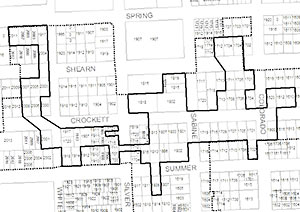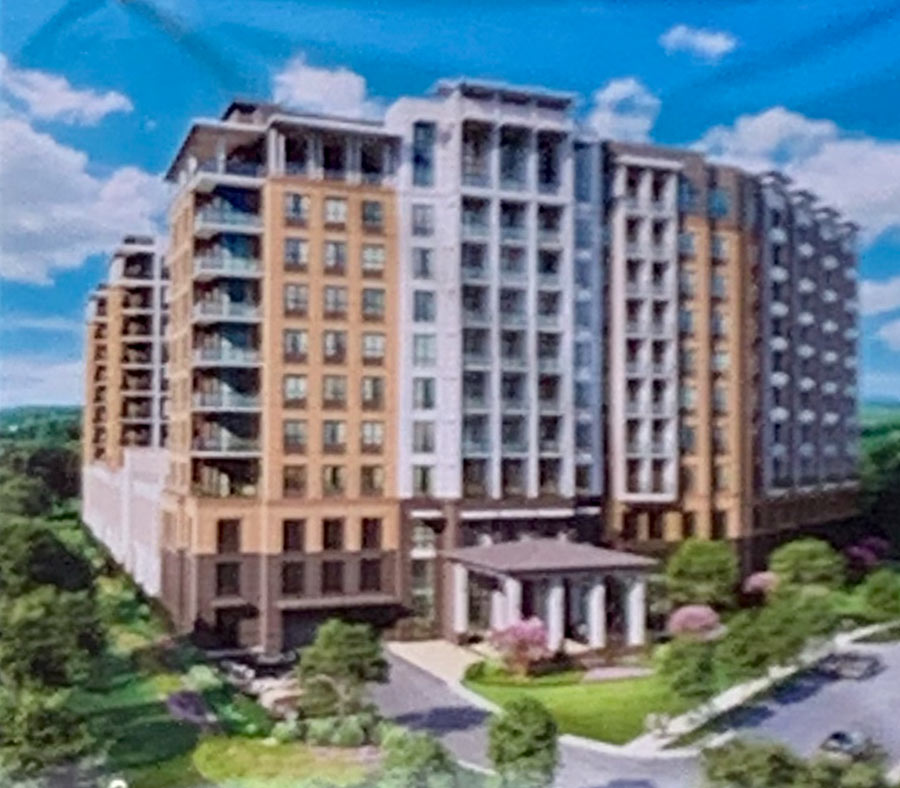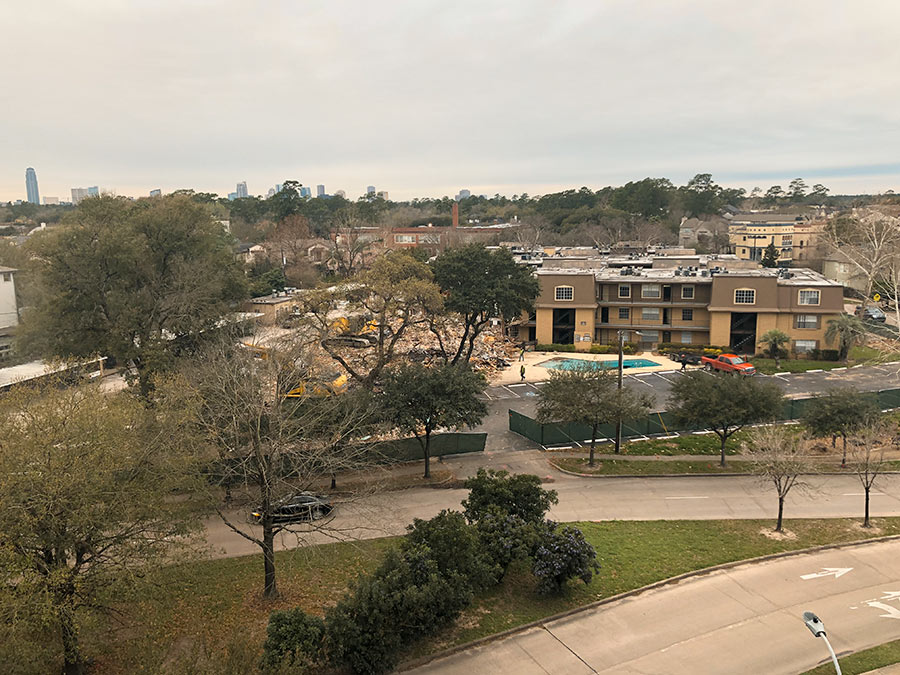HIGH FIRST WARD HISTORIC DISTRICT GETS CITY COUNCIL HIGH FIVE  The High First Ward is the newest historic district in Houston, having been voted in by a 12-5 count of city council members this afternoon. The stringy selection of 55 lots (pictured at right), marked down from the original 149, includes properties along Spring, Shearn, Crockett, Summer, White, Silver, Sabine, and Colorado streets in the First Ward, west of Houston Ave. and south of I-10. According to tweeting Chronicle reporter Mike Morris, a motion by council member Stephen Costello to redraw the district map in order to exclude a couple of properties was rejected by a 4-to-13 vote. [Twitter; previously on Swamplot] Map: HAHC
The High First Ward is the newest historic district in Houston, having been voted in by a 12-5 count of city council members this afternoon. The stringy selection of 55 lots (pictured at right), marked down from the original 149, includes properties along Spring, Shearn, Crockett, Summer, White, Silver, Sabine, and Colorado streets in the First Ward, west of Houston Ave. and south of I-10. According to tweeting Chronicle reporter Mike Morris, a motion by council member Stephen Costello to redraw the district map in order to exclude a couple of properties was rejected by a 4-to-13 vote. [Twitter; previously on Swamplot] Map: HAHC





Time to start doing some Deomolition by Neglect ;)
I’m all for Historic Districts, but this is a disjointed mess that will have no real feel of an Historic District. It’s just like a block or two and they’re not even really together. I suppose something is better than nothing, but that’s about as positive as I can be, this is hardly something to really celebrate, it’s like a truly Houston answer to preservation. How about a trip to New Orleans or San Antonio to see how this sort of thing is really done.
This historic district looks as bad as some of the gerrymandering that occurs where politicians redistrict areas.
It looks like this, and it is unfortunate that it is not the original 149, but it is something. This was so far fetched, but it is amazing if you think about it. The 6th ward is HFW’s neighbor to the South – and is much more together. The difference is the 6th ward is more together (more should have been included) due to the fact most neighbors wanted the district. 1st ward was / is in far worse shape – we are talking pretty run down / dangerous / ghetto, etc… and then Houston’s housing market boomed. 1st area was by far the cheapest for a pretty good location. All this means many places were lost due to developers, many were also lost due to owners who just never took care of their homes… Either way, this is a win. It puts a mark on the community, which should scare away developers looking to make a quick flip… and attract those wanting to help the area realize its potential. I wish more could have been done years ago, but this district contects districts all the way up to the heights from downtown. We should all be thankful that this part of town should retain a historic charm in the future.
This is ridiculous.
You joke commonsense, but there are plenty of people attempting this very thing. At some point they too will get the Terry Fisher treatment.
Stupid. Stupid. Stupid. Can’t Annise find some other agenda to shove down everyone’s throats?
When the City forced historic districts onto Montrose and the Heights, owners throughout them were strongly against it, anywhere from a third to a half of the owners actually. And some of those owners were one-offs along the borders, or along entire blocks, which could have easily been carved out. Yet Annise made the argument that districts should not be disjointed, and so no changes would be made. She wanted large contiguous, easily demarcated districts. Now that they are on the other side of the table (looking to create new districts rather than defend existing ones), look at what they are willing to allow. Total hypocrisy, and desperation to obtain the right % in order to create the district… All these historic districts will just create a large and stagnant residential area of Houston, kind of like River Oaks except with smaller and less equipped properties for the modern family. People will be motivated to own in areas with more / easier rights for building, expansion, modernization. Similarly, businesses will too. This story is great news for the I10 corridor, Spring Branch, Memorial City, Westchase and Energy Corridor. I say, keep it up City Council… Maybe it is inadvertent?
What a waste. New development is a vast improvement over the blight much of the area had become. The gerrymandering historical district is foolish planning by folks who want a Mayberry area with the convenience of the middle of the city. They should be thankful much of the riff raff has been forced out.
I am actually okay with this. Given i am not one of the few owners that might be forced to work on my place with my hands tied. I think even though its a bit gerrymandered, it still could provide a catalysis for a area to have an historic feel. I would buy near the district and build/restore to many of the styles standards required in the district, but make modifications to my taste/budget.
This is terrible news. This is going to lower the value of the homes in the area, and make the area less attractive for others to move into. I hope I am wrong, but how can you fix up some of those homes? Has anyone actually driven by these things? They are literally about to fall down. I wish I could post pictures of them. There windows are boarded up, foundations are a mess(houses are leaning over), siding is falling off and discolored, and chain linked fences holding huge dogs back make you feel very unsafe. The only way to make the areas nicer to knock these things down and build.
I’m a young professional, 30yrs old, and I moved into the area 18 months ago. I have seen so much positive progress over the past 18 months. I hope this doesn’t make all the progress come to a halt. I know now people will look to the heights and Rice Military to build because homes in these locations will likely keep their value.
I’m confused as to why the new townhome row houses on Silver street on part of this historic district. They are big ugly 3 story townhomes that were recently built. How does the process work?
AD, in response to your comment about building from the ground up, I understand that you feel like there should be more progress to breathe more life into the neighborhood. However, the current way developers like Urban Living are going about it is completely the wrong way. They are taking the wrong approach to building a strong, resilient neighborhood that will last for generations.
Developers like UL build to maximize profits without regard to the effects it has on the people who live there and the urban landscape. The streetscape has suffered because of these new townhomes. The open-ness and connection to nature has suffered because of unthoughtful, developer-driven economics, that have no care about who will live in them, and how the community will feel experimentally as a whole.